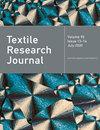提取毛织衣物特征的太赫兹波参数
IF 1.9
4区 工程技术
Q2 MATERIALS SCIENCE, TEXTILES
引用次数: 0
摘要
羊毛是一种天然纤维,价格昂贵,因此在回收纤维市场上非常实用。为了降低纤维分拣的成本,太赫兹波被用来提取羊毛纤维特征光谱信息中的参数。特定表面形状(鳞片形状)和太赫兹测量区域造成的差异被用于识别。通过傅立叶变换红外光谱测量,在 19.4 太赫兹和 19.8 太赫兹之间观察到了羊毛成分的特征。在 19.5 THz 时,随着羊毛含量的增加,反射率从 2.0% 下降到 0.85%。这是由于羊毛表面的鳞片形状造成了散射。羊毛含量超过 80% 的样品在此频率下的反射率为 1.4% 或更低,可以识别。反射率随羊毛含量增加而降低的数学表达式可以成功地表示为指数函数。此外,还证实了样品的表面结构与其在偏振太赫兹波下因编织而产生的各向异性之间的相关性。由于样品的结构特点,存在着 45° 或 90° 的各向异性,这可以通过 40% 的透射率来识别。本文章由计算机程序翻译,如有差异,请以英文原文为准。
Extraction of terahertz wave parameters that characterize woollen clothes
Wool is a natural fiber with a high price, making it practical in the recycled fiber market. To reduce the cost of sorting fibers, terahertz waves have been used to extract parameters within the spectral information that is characteristic of wool fiber. Differences due to the specific surface shape (scale shape) and the terahertz measurement area were utilized for the identification. Characteristic features of wool content were observed between 19.4 THz and 19.8 THz by Fourier transform infrared spectroscopy measurements. At 19.5 THz, the reflectance decreased from 2.0% to 0.85% as the wool content increased. This is due to the scale shape of the wool surface causing scattering. Samples with more than 80% wool could be identified by 1.4% or less reflectance at this frequency. A mathematical expression for a reflectance that decreases as the wool content increases can be successfully expressed as an exponential function. In addition, a correlation between the surface structure of the sample and its anisotropy due to weaving to the polarized terahertz wave was confirmed. Due to the structural characteristics of the sample, there is an anisotropy of 45° or 90° which could be identified by a transmittance of 40%.
求助全文
通过发布文献求助,成功后即可免费获取论文全文。
去求助
来源期刊

Textile Research Journal
工程技术-材料科学:纺织
CiteScore
4.00
自引率
21.70%
发文量
309
审稿时长
1.5 months
期刊介绍:
The Textile Research Journal is the leading peer reviewed Journal for textile research. It is devoted to the dissemination of fundamental, theoretical and applied scientific knowledge in materials, chemistry, manufacture and system sciences related to fibers, fibrous assemblies and textiles. The Journal serves authors and subscribers worldwide, and it is selective in accepting contributions on the basis of merit, novelty and originality.
 求助内容:
求助内容: 应助结果提醒方式:
应助结果提醒方式:


